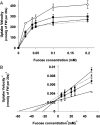Structurally reduced monosaccharide transporters in an evolutionarily conserved red alga
- PMID: 17497961
- PMCID: PMC1948957
- DOI: 10.1042/BJ20070448
Structurally reduced monosaccharide transporters in an evolutionarily conserved red alga
Abstract
The unicellular red alga Galdieria sulphuraria is a facultative heterotrophic member of the Cyanidiaceae, a group of evolutionary highly conserved extremophilic red algae. Uptake of various sugars and polyols is accomplished by a large number of distinct plasma membrane transporters. We have cloned three transporters [GsSPT1 (G. sulphuraria sugar and polyol transporter 1), GsSPT2 and GsSPT4], followed their transcriptional regulation and assayed their transport capacities in the heterologous yeast system. SPT1 is a conserved type of sugar/H(+) symporter with 12 predicted transmembrane-spanning domains, whereas SPT2 and SPT4 represent monosaccharide transporters, characterized by only nine hydrophobic domains. Surprisingly, all three proteins are functional plasma membrane transporters, as demonstrated by genetic complementation of a sugar uptake-deficient yeast mutant. Substrate specificities were broad and largely redundant, except for glucose, which was only taken up by SPT1. Comparison of SPT1 and truncated SPT1(Delta1-3) indicated that the N-terminus of the protein is not required for sugar transport or substrate recognition. However, its deletion affected substrate affinity as well as maximal transport velocity and released the pH dependency of sugar uptake. In line with these results, uptake by SPT2 and SPT4 was active but not pH-dependent, making a H(+) symport mechanism unlikely for the truncated proteins. We postulate SPT2 and SPT4 as functional plasma membrane transporters in G. sulphuraria. Most likely, they originated from genes encoding active monosaccharide/H(+) symporters with 12 transmembrane-spanning domains.
Figures





Similar articles
-
Different sugar kinases are involved in the sugar sensing of Galdieria sulphuraria.Plant Physiol. 2002 Jan;128(1):291-9. Plant Physiol. 2002. PMID: 11788774 Free PMC article.
-
Comparative genomics of two closely related unicellular thermo-acidophilic red algae, Galdieria sulphuraria and Cyanidioschyzon merolae, reveals the molecular basis of the metabolic flexibility of Galdieria sulphuraria and significant differences in carbohydrate metabolism of both algae.Plant Physiol. 2005 Feb;137(2):460-74. doi: 10.1104/pp.104.051169. Plant Physiol. 2005. PMID: 15710685 Free PMC article.
-
EST-analysis of the thermo-acidophilic red microalga Galdieria sulphuraria reveals potential for lipid A biosynthesis and unveils the pathway of carbon export from rhodoplasts.Plant Mol Biol. 2004 May;55(1):17-32. doi: 10.1007/s11103-004-0376-y. Plant Mol Biol. 2004. PMID: 15604662
-
Monosaccharide transporters in plants: structure, function and physiology.Biochim Biophys Acta. 2000 May 1;1465(1-2):263-74. doi: 10.1016/s0005-2736(00)00143-7. Biochim Biophys Acta. 2000. PMID: 10748259 Review.
-
The extended GLUT-family of sugar/polyol transport facilitators: nomenclature, sequence characteristics, and potential function of its novel members (review).Mol Membr Biol. 2001 Oct-Dec;18(4):247-56. doi: 10.1080/09687680110090456. Mol Membr Biol. 2001. PMID: 11780753 Review.
Cited by
-
Identification of an l-Arabitol Transporter from Aspergillus niger.Biomolecules. 2023 Jan 17;13(2):188. doi: 10.3390/biom13020188. Biomolecules. 2023. PMID: 36830558 Free PMC article.
-
Integration of a Galdieria plasma membrane sugar transporter enables heterotrophic growth of the obligate photoautotrophic red alga Cynanidioschyzon merolae.Plant Direct. 2019 Apr 8;3(4):e00134. doi: 10.1002/pld3.134. eCollection 2019 Apr. Plant Direct. 2019. PMID: 31245772 Free PMC article.
-
Involvement of PaSNF1 in Fungal Development, Sterigmatocystin Biosynthesis, and Lignocellulosic Degradation in the Filamentous Fungus Podospora anserina.Front Microbiol. 2020 Jun 10;11:1038. doi: 10.3389/fmicb.2020.01038. eCollection 2020. Front Microbiol. 2020. PMID: 32587577 Free PMC article.
-
Impact of procedural steps and cryopreservation agents in the cryopreservation of chlorophyte microalgae.PLoS One. 2013 Nov 11;8(11):e78668. doi: 10.1371/journal.pone.0078668. eCollection 2013. PLoS One. 2013. PMID: 24244336 Free PMC article.
-
Heterotrophic growth of microalgae: metabolic aspects.World J Microbiol Biotechnol. 2015 Jan;31(1):1-9. doi: 10.1007/s11274-014-1773-2. Epub 2014 Nov 12. World J Microbiol Biotechnol. 2015. PMID: 25388473 Review.
References
-
- Sauer N., Tanner W. The hexose carrier from Chlorella cDNA cloning of a eucaryotic H+-cotransporter. FEBS Lett. 1989;259:43–46. - PubMed
-
- Wolf K., Tanner W., Sauer N. The Chlorella H+/hexose cotransporter gene. Curr. Genet. 1991;19:215–219. - PubMed
-
- Caspari T., Stadler R., Sauer N., Tanner W. Structure/function relationship of the Chlorella glucose/H+ symporter. J. Biol. Chem. 1994;269:3498–3502. - PubMed
-
- Caspari T., Will A., Opekarova M., Sauer N., Tanner W. Hexose/H+ symporters in lower and higher plants. J. Exp. Biol. 1994;196:483–491. - PubMed
Publication types
MeSH terms
Substances
Associated data
- Actions
- Actions
- Actions
LinkOut - more resources
Full Text Sources

